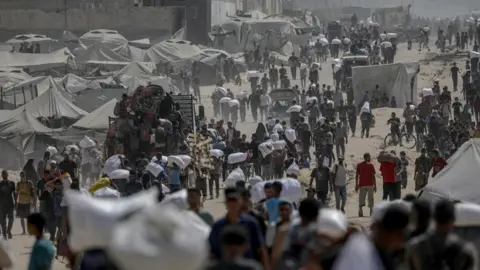The humanitarian situation in Gaza is dire, with recent reports from the Hamas-run health ministry indicating that eleven additional individuals have succumbed to malnutrition. This grim announcement brings the total number of malnutrition-related deaths to 212 since the beginning of intensified armed conflict, which includes a harrowing figure of 98 affected children. The health ministry also reported escalating violence, noting that at least 38 individuals have lost their lives and an additional 491 have sustained injuries due to Israeli military actions over the previous 24 hours.
The continuing rise in fatalities is compounded by critical deadlines emerging from the Israeli government regarding the future of Gaza City. A contentious plan has been outlined for residents to evacuate the city by October 7, 2025, a date set amidst a backdrop of significant military operations. This plan, as articulated by the Israeli security cabinet, includes five core principles aimed at resolving the conflict, one of which focuses on establishing control over the territory.
Israeli media outlets suggest that the initiative primarily targets complete control of Gaza City, effectively forcing its estimated one million residents to relocate further south. This strategy has sparked widespread criticism from global leaders and has met with substantial resistance within Israel itself. This resistance includes opposition from military officials as well as from families of hostages believed to still be in Gaza, who are increasingly concerned for their loved ones’ safety.
Despite the public pushback, Israel’s government remains resolute. Defence Minister Israel Katz dismissed the criticism, asserting that such condemnation would not deter their objectives. On the international front, reactions have varied; notable figures like Donald Trump have indicated that the decision to occupy Gaza is ultimately Israel’s to make, portraying a more lenient perspective compared to other nations’ responses.
Within Israeli military circles, preparations are reportedly in place to initiate a two-month countdown leading to a potential military siege of Gaza City, coinciding with the war’s two-year anniversary. This strategy involves extensive efforts to displace possibly half of Gaza’s total population, effectively creating a humanitarian disaster and intensifying struggles for the survival of the people already coping with acute shortages of food and basic necessities.
The situation is particularly grave in Gaza City, which, prior to the current conflict, had a population of approximately 600,000. This number has swelled as residents from other parts of Gaza have sought refuge in the city, exacerbating overcrowding and elevating the risk of starvation and disease. Reports indicate that many families, having already been displaced multiple times, are now forced to live in makeshift shelters amidst the ruins of their homes, greatly impacting their ability to secure food and essential services.
Unsurprisingly, humanitarian organizations have condemned the impending plans to control Gaza City, warning they could lead to historically high levels of suffering among an already beleaguered population. United Nations (UN) representatives have voiced concerns that a potential famine is manifesting, with access to ongoing aid efforts falling drastically short of actual needs. The UN’s announcements have sparked disputes, with Israeli officials asserting that there is no starvation crisis and implying that aid agencies are not acting effectively in their distribution efforts.
As the deadline for evacuation looms, there are reports of further deaths connected to individuals searching for food—a reality that underscores the significant obstacles lingering in the distribution of humanitarian aid. Just recently, Gaza’s health ministry noted 21 fatalities occurring within a single day due to food shortages. Since the introduction of the Gaza Humanitarian Foundation’s aid distribution centers two months ago, over 1,300 Palestinians have died, according to UN statistics, heightening scrutiny and concern regarding safety at these aid locations.
Amid these grave circumstances, Israeli officials maintain that the military does not intend to target civilians, asserting that chaos is often instigated by groups like Hamas. Independent verification remains challenging, as media presence within Gaza is heavily restricted, further complicating the task of documenting the real-time human impact of this ongoing conflict.
In summary, the humanitarian crisis in Gaza is escalating rapidly, with soaring numbers of malnutrition-related deaths and increasing military actions threatening the lives of thousands. As tensions persist, the optics of population control, military strategy, and humanitarian efforts intertwine, presenting a complex web of challenges that must be addressed urgently for the sake of the affected civilian population.











